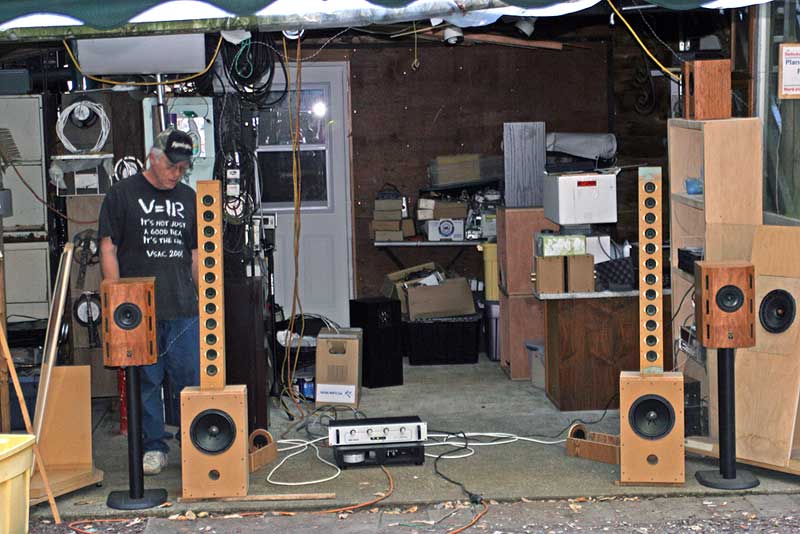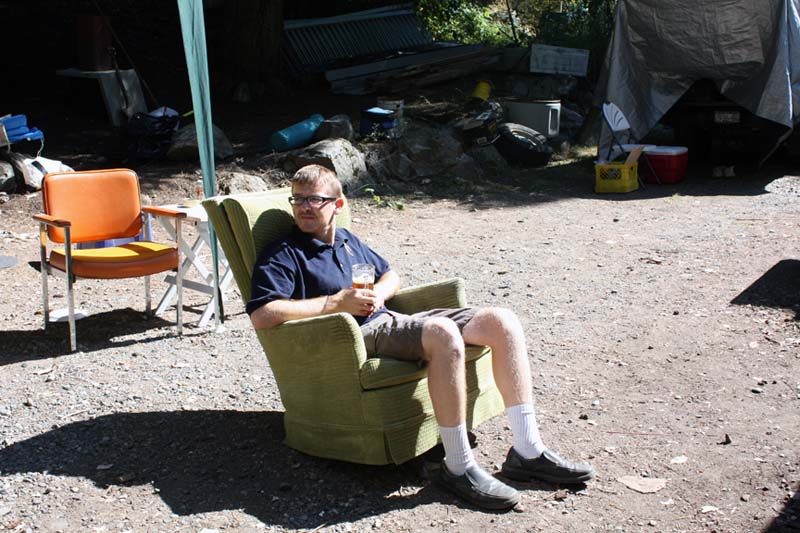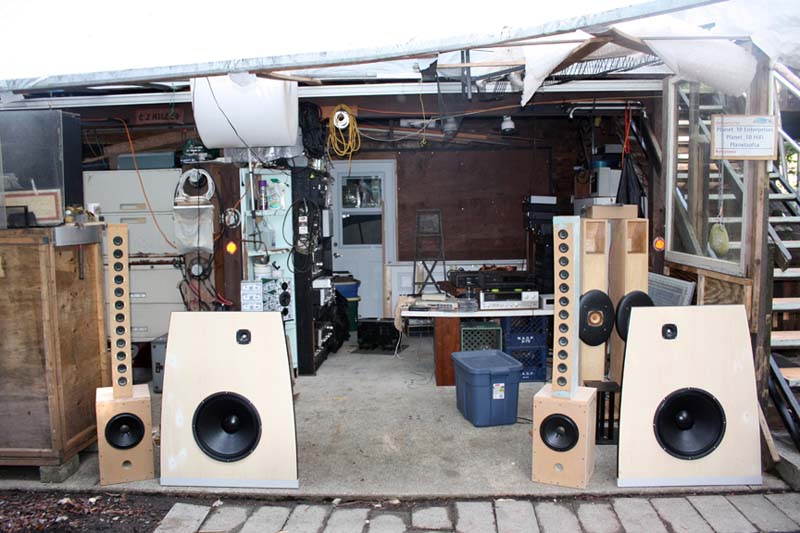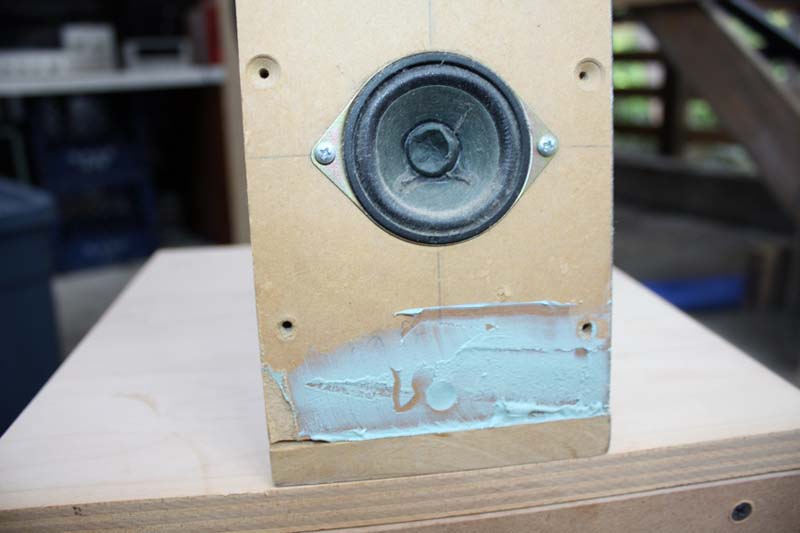This may have been debated before BUT...
Do line arrays really lose HF output because of comb filtering in nearfield situations or is it because of inherent beaming in drivers above a certain frequency that youre actually only listening to the full HF extension of those drivers you are at ear level to? I understand you will obviously have cancellation etc at certain measurable points, but at any given point it will be frequency dependant, it doesnt mean ALL HF frequencies are cancelled at all points over a broad range of frequencies.
I'm building 2.2m tall arrays at the moment with 36 x 2" drivers each(and bass) and I'll only be sitting around 3-4m from them SO I'll be significantly off axis to the top and bottom drivers therefore not hearing their full hf extension. This is also why I believe curved arrays suffer less from this because you are on axis to all drivers.
a 2" driver may be 6db down at 10khz at 30 deg off axis but more ore less full output 30deg off axis at 2khz. So automatically you're 3-6db down purely from that perspective. So at 2khz you hear full spl from all 36 drivers per side, but only full on axis output from the centre drivers.
I'll be hiding a single tweeter to one side of the array behind the grille for the woofers with an l-pad for tweaking anyway 😀
Do line arrays really lose HF output because of comb filtering in nearfield situations or is it because of inherent beaming in drivers above a certain frequency that youre actually only listening to the full HF extension of those drivers you are at ear level to? I understand you will obviously have cancellation etc at certain measurable points, but at any given point it will be frequency dependant, it doesnt mean ALL HF frequencies are cancelled at all points over a broad range of frequencies.
I'm building 2.2m tall arrays at the moment with 36 x 2" drivers each(and bass) and I'll only be sitting around 3-4m from them SO I'll be significantly off axis to the top and bottom drivers therefore not hearing their full hf extension. This is also why I believe curved arrays suffer less from this because you are on axis to all drivers.
a 2" driver may be 6db down at 10khz at 30 deg off axis but more ore less full output 30deg off axis at 2khz. So automatically you're 3-6db down purely from that perspective. So at 2khz you hear full spl from all 36 drivers per side, but only full on axis output from the centre drivers.
I'll be hiding a single tweeter to one side of the array behind the grille for the woofers with an l-pad for tweaking anyway 😀
Last edited:
Yes, line sources made from wideband drivers do suffer from HF loss, or to put it another way, array gain is concentrated on the low end & the response rolls off ~1st order above x frequency (depending on driver size & response) until it hits the inherent sensitivity of a single unit, or a little below, whereupon it usually tends to level off. Therefore, they need some form of Eq, active or passive, take your pick. The former is preferable insofar as you can take advantage of the extra efficiency on the bottom end, where it's most useful, but passive works fine if you're willing to accept a system sensitivity ~that of a single example of the drive unit you're using.
The 1-wavelength, or preferably 1/2 wavelength (of the highest frequency to be reproduced) centre-to-centre spacing ROT between drive units is the ideal. However, it is a little over-simplified since it doesn't account for the rising on-axis response of many wideband drivers, which can go a little way to countering HF losses. Nor does it take into consideration the narrowing power-response many wideband drivers exhibit with rising frequency, which again can help a little, particularly since human hearing is less effective in the vertical axis.
The 1-wavelength, or preferably 1/2 wavelength (of the highest frequency to be reproduced) centre-to-centre spacing ROT between drive units is the ideal. However, it is a little over-simplified since it doesn't account for the rising on-axis response of many wideband drivers, which can go a little way to countering HF losses. Nor does it take into consideration the narrowing power-response many wideband drivers exhibit with rising frequency, which again can help a little, particularly since human hearing is less effective in the vertical axis.
flat array of 32 x 2" drivers.
Parts Express: Project Showcase
There are some flat arrays using a driver's rising response to combat losing high end. The audience lsa4.
Audiogon Shows: RMAF 2007
here was a driver they used.
http://www.parts-express.com/pdf/296-220s.pdf
+5db 2.5khz-7khz, a peak, then a bit more above that.
More drivers and you'd lose more highend.
I am one who carries the focused array torch, but it has more drawbacks than most would tolerate.
http://speakers.sub-optimal.net/displayimage.php?album=16&pos=6
Norman
Parts Express: Project Showcase
There are some flat arrays using a driver's rising response to combat losing high end. The audience lsa4.
Audiogon Shows: RMAF 2007
here was a driver they used.
http://www.parts-express.com/pdf/296-220s.pdf
+5db 2.5khz-7khz, a peak, then a bit more above that.
More drivers and you'd lose more highend.
I am one who carries the focused array torch, but it has more drawbacks than most would tolerate.
http://speakers.sub-optimal.net/displayimage.php?album=16&pos=6
Norman
Last edited:
... I am one who carries the focused array torch, but it has more drawbacks than most would tolerate.
Uplake Speaker Hut - Northwest Washington DIY Audio Meet 2004/Adire Front Office
Norman
How much does the multi-cavity ferrous wall resonator in between the speakers affect the sound?
I have a suspicion that the drawbacks of focused arrays can be overstated; since the radius of the curve ideally wants to be = to the listening distance, the horizontal sweet spot is unlikely to be as severely restricted at longer distances as it is if you go for a closer position & more extreme curve. FWIW.
Line arrays which curve in a concave manner severely limit the listening area in my opinion. Conversely, convex curved arrays (like Don Keele's CBT work) have much better dispersion and would also cover near or far listening distances much better than concave arrays. My choice would be a convex array per Keele's work.
Line arrays which curve in a concave manner severely limit the listening area in my opinion. Conversely, convex curved arrays (like Don Keele's CBT work) have much better dispersion and would also cover near or far listening distances much better than concave arrays. My choice would be a convex array per Keele's work.
I second that...
Hi
It isn’t that there is hf loss with a line array but rather that the sources never combine into a single radiation, they radiate as independent sources. As independent sources, they sum together per Huygens construction also producing an interference pattern depending on the phase angle from each sources which is then dependent on the distance to each source at the listening position..
To acoustically add into a single source, the sources cannot be more than about ¼ wavelength part which is difficult to achieve and very rarely done in the concert style arrays. The Yorkville execution of the Paraline being one of the exceptions to that generalization.
Also a down side to the concert line array approach is that because the distance to the individual sources changes with your position in the audience, one finds the frequency response changes continuously with your position as well, the only places you can actually measure the true response of a line array is at zero distance and at acoustic infinity.
Another down side so far as “signal fidelity” is that each hf source etc has an individual time of arrival and so a single impulsive input arrives stretched out in time per the variation in distance.
A big upside for the mfr’s of such systems is that with a system that depends on self cancellation to work as advertised, it requires a lot more drivers, amplifier channels and DSP that “if” one could make a powerful enough point source.
When you can make such a point source that has constant directivity, then you are free from a changing response with position and can aim the speaker such that the SPL and frequency response is very nearly constant over a very large area and if the wind blows, there is no audible effect unlike with an interference pattern based system.
Don Keeles CBT and the whole J array shape are ways of making a line array act more like a point source, reducing the line array effect. In these cases the idea is to make a system with vertical pattern control and aim it at the back row so that the spl changes more slowly than on axis, just like with the point source.
Best,
Tom Danley
It isn’t that there is hf loss with a line array but rather that the sources never combine into a single radiation, they radiate as independent sources. As independent sources, they sum together per Huygens construction also producing an interference pattern depending on the phase angle from each sources which is then dependent on the distance to each source at the listening position..
To acoustically add into a single source, the sources cannot be more than about ¼ wavelength part which is difficult to achieve and very rarely done in the concert style arrays. The Yorkville execution of the Paraline being one of the exceptions to that generalization.
Also a down side to the concert line array approach is that because the distance to the individual sources changes with your position in the audience, one finds the frequency response changes continuously with your position as well, the only places you can actually measure the true response of a line array is at zero distance and at acoustic infinity.
Another down side so far as “signal fidelity” is that each hf source etc has an individual time of arrival and so a single impulsive input arrives stretched out in time per the variation in distance.
A big upside for the mfr’s of such systems is that with a system that depends on self cancellation to work as advertised, it requires a lot more drivers, amplifier channels and DSP that “if” one could make a powerful enough point source.
When you can make such a point source that has constant directivity, then you are free from a changing response with position and can aim the speaker such that the SPL and frequency response is very nearly constant over a very large area and if the wind blows, there is no audible effect unlike with an interference pattern based system.
Don Keeles CBT and the whole J array shape are ways of making a line array act more like a point source, reducing the line array effect. In these cases the idea is to make a system with vertical pattern control and aim it at the back row so that the spl changes more slowly than on axis, just like with the point source.
Best,
Tom Danley
Thanks for that Tom (as always 🙂 )
Agreed Jim, that's the big negative with focused arrays. I suspect it will always be a case of YMMV whether it's worth it or not; line sources, CBT & focused types all seem to find users.
Agreed Jim, that's the big negative with focused arrays. I suspect it will always be a case of YMMV whether it's worth it or not; line sources, CBT & focused types all seem to find users.
Last edited:
This is also why I believe curved arrays suffer less from this because you are on axis to all drivers.
This is correct.
That's not to say they are ultimately better for all situations.
Only for the situation of critical listening at an exact distance from the arrays.
Some people like to sit in 1 spot and listen, some people just want to get up and boogie. 😀
Me.....I have no 1 preference, I think every situation calls for a certain solution.
I have a focused array, I have point sources, I am building a straight line array in a couple of weeks.
IINM, the curved line array shown here is by Terry O (using a PartsExpress clearout driver) - by all accounts the sweet spot is very tiny. He's brought these to a couple of local hobby-fests - I've never taken the time to sit in "the chair"
An externally hosted image should be here but it was not working when we last tested it.
I have point sources,
Hi
Keep in mind that if one has a multi-way speaker, it is generally an array of point sources which produce an interference pattern in the crossover region (where an upper and lower driver are both radiating the same sound) while a tiny full range driver is usually a point source below the top end where it’s large enough to have directivity / or is operating in it’s breakup mode.
AS with any multiple source arrangement, they only combine in to one acoustic source when they are less than a quarter wavelength apart.
There are very very few true acoustic point source speakers that are full range speakers, a quad esl-63 and a Manger being two that come to mind.
Best,
Tom
Hi
Keep in mind that if one has a multi-way speaker, it is generally an array of point sources which produce an interference pattern in the crossover region (where an upper and lower driver are both radiating the same sound) while a tiny full range driver is usually a point source below the top end where it’s large enough to have directivity / or is operating in it’s breakup mode.
AS with any multiple source arrangement, they only combine in to one acoustic source when they are less than a quarter wavelength apart.
There are very very few true acoustic point source speakers that are full range speakers, a quad esl-63 and a Manger being two that come to mind.
Best,
Tom
I am one who carries the focused array torch, but it has more drawbacks than most would tolerate.
Uplake Speaker Hut - Northwest Washington DIY Audio Meet 2004/Adire Front Office
Terry O has brought his famous curved arrays to diyFEST at least a couple times.

They produce a very interesting soundfield -- oft described as big headphones. If you are out of the sweet spot they have issues, in the sweet spot they are really quite amazing (especially when you consider the low cost of the 2" RS drivers).
I couldn't find any pictures of a lone chair, pulled way out in front of the normal listening sweet spot, the listener obviously enjoying his experience.
dave
I couldn't find any pictures of a lone chair, pulled way out in front of the normal listening sweet spot, the listener obviously enjoying his experience.
A shot with more context would better convey the idea, but i did find these from the year previous to the above.


and a close up of one of the drivers (and TO's trademark "tone sauce")

dave
...
and a close up of one of the drivers (and TO's trademark "tone sauce")

dave
not to mention the cone treatment - meticulously calibrated, and as always, elegantly executed
Hi
It isn’t that there is hf loss with a line array but rather that the sources never combine into a single radiation, they radiate as independent sources. As independent sources, they sum together per Huygens construction also producing an interference pattern depending on the phase angle from each sources which is then dependent on the distance to each source at the listening position..
To acoustically add into a single source, the sources cannot be more than about ¼ wavelength part which is difficult to achieve and very rarely done in the concert style arrays. The Yorkville execution of the Paraline being one of the exceptions to that generalization.
Also a down side to the concert line array approach is that because the distance to the individual sources changes with your position in the audience, one finds the frequency response changes continuously with your position as well, the only places you can actually measure the true response of a line array is at zero distance and at acoustic infinity.
Another down side so far as “signal fidelity” is that each hf source etc has an individual time of arrival and so a single impulsive input arrives stretched out in time per the variation in distance.
A big upside for the mfr’s of such systems is that with a system that depends on self cancellation to work as advertised, it requires a lot more drivers, amplifier channels and DSP that “if” one could make a powerful enough point source.
When you can make such a point source that has constant directivity, then you are free from a changing response with position and can aim the speaker such that the SPL and frequency response is very nearly constant over a very large area and if the wind blows, there is no audible effect unlike with an interference pattern based system.
Don Keeles CBT and the whole J array shape are ways of making a line array act more like a point source, reducing the line array effect. In these cases the idea is to make a system with vertical pattern control and aim it at the back row so that the spl changes more slowly than on axis, just like with the point source.
Best,
Tom Danley
An externally hosted image should be here but it was not working when we last tested it.
I'm loving the Paraline technology. It may not be obvious, but the Paraline is an excellent replacement for the tweeter line in the Keele CBT arrays. A single compression driver is more efficient than twenty of the tweeters used in the CBT array.
(The reason that it's not obvious is because no one has bent a Paraline (yet.) But it should be do-able, just get the plywood wet and bend it.)
Thankyou for the various informative comments, I think I have a pretty good understanding now of what is going on. I will just go with active eq and tweak as necessary.
I'm aiming for an almost floor to ceiling 'infinite array'. I'm not so much looking for a sweet spot speaker(although I'm sure it will have one) but if I have one in/near each corner in my fairly large open plan lounge area, will it sound ok if I'm walking around doing other stuff and for parties? SPL should be no problem(have decided on 4 x 8" bass drivers a side too driven actively in a double TL a side- 4 drivers spaced at the centre on the side with TL exiting one at floor, one at ceiling)
I'm aiming for an almost floor to ceiling 'infinite array'. I'm not so much looking for a sweet spot speaker(although I'm sure it will have one) but if I have one in/near each corner in my fairly large open plan lounge area, will it sound ok if I'm walking around doing other stuff and for parties? SPL should be no problem(have decided on 4 x 8" bass drivers a side too driven actively in a double TL a side- 4 drivers spaced at the centre on the side with TL exiting one at floor, one at ceiling)
- Status
- Not open for further replies.
- Home
- Loudspeakers
- Full Range
- HF loss in line arrays